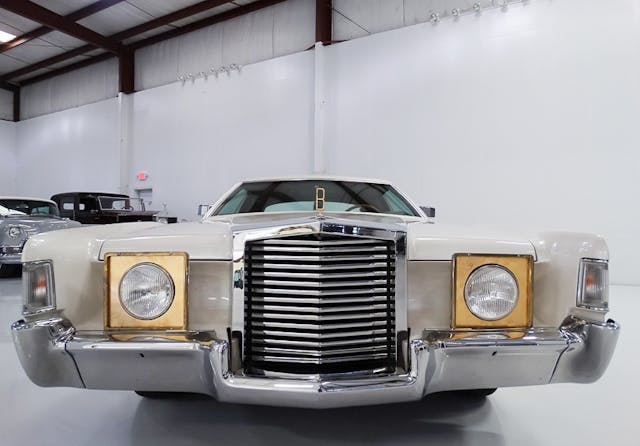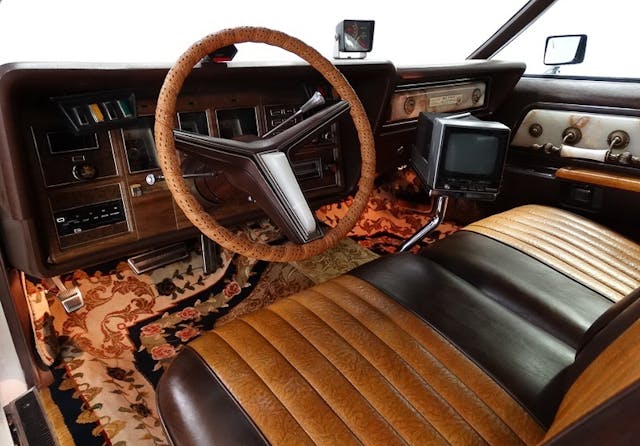Superfly cars are over the top, and that’s why I love them

I’ve been an appraiser for well over 20 years, and over that time I’ve gotten to see some pretty remarkable rides. People even trust me enough to let me judge fancy cars on golf fairways every once in a while. You might think that walking among seven- and eight-figure beauties would change my taste, but I still have my (not so guilty) pleasures.
My name is Dave Kinney, and I love Superfly cars.
Okay, I know that sounds like the kind of confession you’d hear at an anonymous meeting. But Superfly cars are a rolling poke in the eye to the snooty automotive establishment, and for that I can’t get enough of them.
Still, the garish customized cars of the 1970s are definitely not everyone’s cup of Jack and Cola. Notice that I don’t use the word “pimpmobile.” I’m not a fan of this term, though I admit it paints a pretty accurate picture in most people’s minds: a big, over-stylized American luxury car covered in vinyl, chrome, and extravagant paint. Interiors perhaps lavishly decked out with mirrors, shag carpet, and even televisions.

I prefer the “Superfly” moniker, which I think fits even better. Brought into broader use by the 1972 movie, Super Fly, and Curtis Mayfield’s song “Superfly” (one word), the term quickly morphed to mean something cool or incredibly stylish, if gaudy. These cars more than fit that bill.
Let’s be real: This was the ’70s. Lots of Superfly car owners were simply people who liked flash and excess and had the cash to afford it. Back then, I frequently used to see a Superfly car parked outside of an accountant’s office near my hometown. When I finally saw the car on the road, yup, the “numbers man” at the wheel was the CPA that owned the business. Bookkeepers like flash, too.
I dug these cars enough that I bought one in 2005: a Lincoln Mark IV-based “Bugazzi.” Made in California and with a George Barris connection (or at least Barris told me so), the Bugazzi was a short-lived fantasy car, loaded with all the options you might expect for the day. An onboard TV, gold trim, faux external exhaust pipes, padded vinyl half roof, genuine marble trim on the dashboard and in the door panels, the works. The entertainer Danny Thomas bought one new. I enjoyed owning the car, though my wife was a little less than thrilled having it around. I guess she just has poor taste in luxury cars of the 1970s.

You can keep your neo-classics—your Zimmers, Spartans, or later Excaliburs—to me, they’re not in the same league. Although there are a few neo-classics I do like, overall, they aren’t the real deal. For me, they took themselves a little too seriously. I make that distinction because I have discerning taste, though you also might argue it’s more a result of my complete lack of taste. Potato, potahto.
I especially like the cars that were actually built and customized in the 1970s. Mine has to be a two-door, Lincoln or Caddy only. E&G Customs “Rolls” grille please, with Superfly headlights (an homage to Lucas P-100 headlights as seen on many Rolls-Royce Silver Wraiths of the 1950s). I’ll take a padded vinyl top, limo-style reduced rear window, some vinyl trim, chrome belts with buckles on the trunk would be nice. An exposed spare tire (or Continental-style spare), and lots of extra chrome to complete the look. Pure Klass, and with a capital K, for sure.
At this point, you’ve got to be saying, “Dave, how do I learn more about this fascinating sub-genre of cars, and if I want to buy one, what do I need to look for?” It’s as simple as searching for ’70s-era customized luxury cars—I get lost down this rabbit hole on a regular basis. You’ll quickly get a feel for what shops or coachbuilders you like. As far as buying one, there’s a healthy array of price points, and ultimately they’re based on malaise-era domestic cars, so keeping them running is not much different than your typical American collector vehicle.
For those more casually interested in enjoying Superfly cars, I suggest digging up more movies from the ’70s. The James Bond film Live and Let Die features my personal favorite, the Corvorado. Driven by the movie’s villain, Mr. Big (played by Yaphet Kotto), the white-over-red Corvorado was a custom Corvette with design features of a contemporary Eldorado. Conceived by the creative Les Dunham of Dunham Coach in New Jersey, the exaggerated proportions of this outlandish coupe were maximum Superfly.

Even those that didn’t make the silver screen capture attention. Small shops across the country turned out unbridled custom Cadillacs, Lincolns, Buicks, Oldsmobiles and others, and some of the more prominent brands, like Stutz, still pull down good money when they come up for sale. A split-windshield 1971 Stutz Blackhawk went for $212,800 at Gooding’s Amelia sale this year (though later cars are available for substantially less). Evidently, some people share my taste.
Superfly cars might be maligned, and they’re definitely niche. But as the kids say, “if you know, you know.” To the rest, I suggest chasing your own version of fun; don’t let The Man hassle you.
***
Check out the Hagerty Media homepage so you don’t miss a single story, or better yet, bookmark it. To get our best stories delivered right to your inbox, subscribe to our newsletters.
Via Hagerty Insider


Ooooh- swing and a miss! The Corvorado in LALT was driven by Tee-Hee, Mr. Big’s main thug. Still, great article! I appreciate anyone with a genuine, scholarly interest in offbeat automobiles.